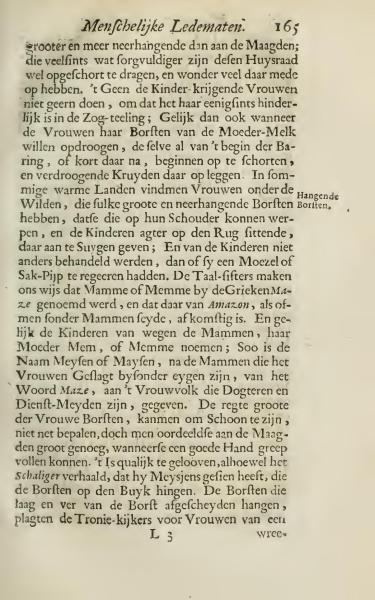Human Limbs.
Larger and more hanging down than those of maidens; who quite often take care to wear this household attire properly fastened, and take great pride in doing so. Child-bearing women do not gladly do this because it is somewhat hindering in nursing. Likewise, when women want to dry out their breasts from mother's milk, they start this from the beginning of childbirth, or shortly thereafter, by lifting them and placing drying herbs upon them. In some warm countries, there are women among the indigenous peoples with such large and drooping breasts that they can throw them over their shoulders, and while sitting, allow the children on their backs to suckle from them. The children were treated as if they were managing a pouch or sackpipe. Language scholars tell us that the terms 'Mamme' or 'Memme' among the Greeks were called 'Maze', and that from there, the word 'Amazon' derives, as if saying 'without breasts'. Just as children, because of the breasts, call their Mother 'Mem' or 'Memme'; thus the name 'Meyssen' or 'Maysen', which is peculiar to the female gender, comes from the word 'Maze', given to womenfolk who are daughters and servants. The proper size of a woman's breasts, came to be beautiful, not just determined, but decided as being ample enough when a good hand could grasp them fully. It is hard to believe, though Schaliger reported, that he saw women whose breasts hung down to their waist. The breasts that hang far and separate from the chest bother the viewers of women with a modest disposition.
Translation Notes:
1. 'Maze': An ancient term possibly referring to breast shape or function.
2. 'Amazon': Refers to the mythical tribe of warrior women believed to have one breast.
The text discusses how women's breasts vary in size and shape, especially comparing those of maidens and mothers. It mentions traditional practices for managing and drying the breasts among different cultures. The etymology of terms related to 'breast' is explored, along with historical references, such as the Amazons.
